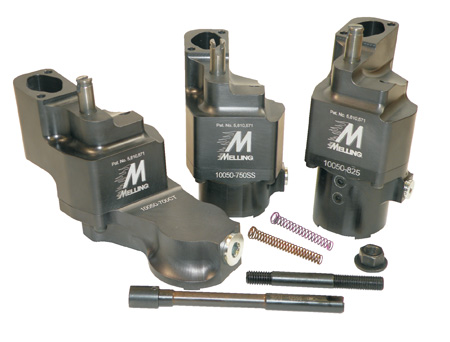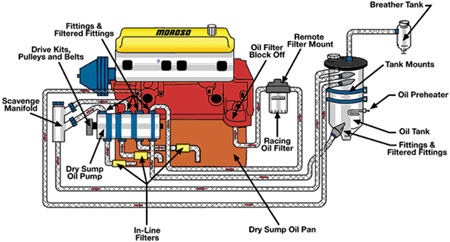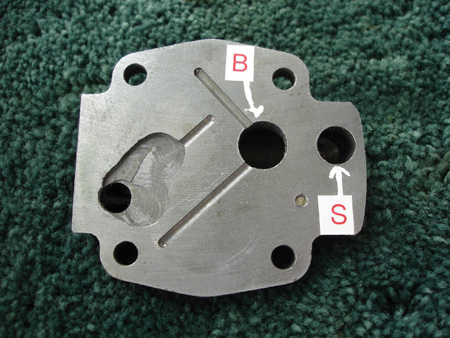It’s 6,000 rpm – do you know what your oil pressure is? That’s a question every engine builder should know the answer to if they’re building an engine that’s going to survive.
Maintaining adequate oil pressure and volume is absolutely essential for engine durability. The problem is the output of many stock oil pumps, particularly small block Chevy oil pumps, levels off around 5,000 rpm. At that speed, the straight cut gear teeth are skimming over the pump inlet port so quickly there isn’t time to completely fill the voids between the gear teeth with oil. Cavitation forms air bubbles that reduce the volume of oil being pushed through the pump. That, in turn, causes the pump’s output to level off. Oil volume and pressure level off or may even drop.
In a stock motor that doesn’t rev beyond 5,500 rpm, that’s not a concern. But in a performance engine that’s capable of being revved to 8,500 rpm, 9,000 rpm or even higher, a drop in oil volume and pressure could be disastrous.
When a performance engine throws a connecting rod, the underlying cause of the failure often turns out to be a lubrication problem. If the oil pump can’t maintain enough oil flow to the rod bearings, the oil film between the bearings and crank will go away causing the bearing to seize, spin and break the rod. A blackened or blued crankshaft journal is usually proof that the bearing spun and caused the rod failure.
The old school rule of engine building says that most engines need about 10 psi of oil pressure for every 1,000 rpm. That’s still good advice for the average Saturday night racer. But many ProStock drag racers and NASCAR racers are now running significantly less pressure (up to 40 percent less) to reduce the horsepower loss needed to drive the oil pump – which is okay provided bearing clearances are tight and you have enough oil volume to keep everything adequately lubricated.
Many top racers today are also running extremely low viscosity 0W-20 synthetic oil. The lower viscosity of the oil means less resistance to flow, so it takes less horsepower to pump the oil. Zero weight oils also shed more quickly from moving parts, which reduces drag and allows faster acceleration. But extremely thin oils require oil pumps and bearings with close tolerances.
Any form of racing that subjects the oil inside the engine to high G-forces also creates problems for the oil pump and lubrication system. If the engine has an internal wet sump oil system, oil can slosh away from the oil pump pickup tube as the vehicle dynamics change. In a circle track or road race engine, the oil wants to slosh sideways away from the pickup every time the car enters a curve. In a drag race motor, the oil wants to climb up the back of the pan and crankcase when the car launches off the line and accelerates down the strip. In an off-road car or truck, the oil can go just about anywhere inside the crankcase when the vehicle becomes airborne. And the thinner the oil, the more it can slosh around inside an oil pan.
No oil pump can maintain oil pressure and a constant supply of oil to the engine if the pickup tube is sucking air. Consequently, wet sump systems in performance engines require baffles inside the oil pan to control the movement of the oil. A well-designed oil pan can do a great job of keeping oil where it belongs so the pump has a steady supply of oil to draw upon.
DRY SUMP SYSTEMS
The other approach to handling high G-force applications is to convert the engine to a dry sump oiling system. These are used by most ProStock drag racers as well as NASCAR and circle track racers.
With a dry sump setup, there is no oil in the pan. One or more scavenge pumps suck the oil out of the pan (and lifter valley in some cases) as fast as the oil flows through the bearings and lifters. The scavenge pump(s) route the oil to an external storage tank, which may hold anywhere from one to five or more gallons of oil. The external tank serves as a reservoir and allows air to separate from the oil. A vent allows air to escape.
Dry sump systems are usually described by the number of stages (pumps) they have, such as 3-stage, 4-stage, 5-stage, etc. Typically, the external pump assembly will include 2 to 5 scavenge pumps mounted in a row, with the pressure pump at the back end of the stack.
In a very simple 2-stage dry sump system, two pumps are stacked together: a scavenge pump to suck oil out of the oil pan, and a pressure pump to feed oil back into the engine from the reservoir. When multiple scavenge pumps are stacked together (usually 3 or more), there’s usually enough scavenging action to suck not only the oil out of the engine but also air from the crankcase. Pulling a vacuum in the crankcase reduces windage and drag for more horsepower. In a high revving engine, pulling vacuum may increase the engine’s power output up to 10 horsepower or more.
The oil pan usually has two to four suction ports that are connected to the scavenge pumps with hoses. The oil pan is also quite shallow since it doesn’t have to hold any oil. This increases ground clearance under the engine and allows the engine to be mounted lower in the chassis for a better center of gravity. The oil pan may be cast aluminum, or welded steel or aluminum.
Gary Armstrong of Armstrong Race Engineering says his company makes a wide variety of cast aluminum dry sump oil pans. “Our most popular pan right now is for the LS1-LS7 Chevy applications. These are all bolt-on pans that use the stock gaskets.”
To push the oil back into the engine, a dry sump system uses an external pressure pump, which is usually mounted in the same stack as the scavenge pumps (all share a common driveshaft that runs down the middle of the assembly). The pump’s output is routed directly to the engine’s crankshaft bearings with hose fittings and an adapter that fits over the old spin-oil filter mount, but some of the oil can also be routed through a valve block or manifold to provide lubrication direct to the valvetrain and/or turbocharger.
The dry sump pumps are usually mounted on the side of the engine and driven with a cogged belt off the crank pulley. On some applications (sprint cars, for example), the pump assembly may be mounted on the front timing cover and are driven off the cam.
Because most 3-stage dry sump systems do not have enough suction to pull vacuum in an engine, racers who want to minimize windage and drag usually go with a 4-stage, 5-stage or 6-stage setup. Tim Mangus of Mangus Precision Pumps says “Bigger motors need more scavenging if you want to pull vacuum in the crankcase.
“With a 4-, 5- or 6-stage dry sump setup, you can also separate the top and bottom of the engine, and pull oil out of each separately. This keeps oil from running down onto the crankshaft and increasing windage and drag. It also protects the bottom end of the engine if something in the top end breaks and fails,” says Mangus.
Wade Moon of Peterson fluid Systems says many racers are using 4-, 5- or 6-stage dry sump systems today so they can pull vacuum. “People are always asking for smaller pumps and lighter pumps. So we are introducing a new RPM (Radial Ported Modular) pump design that allows pumps to be easily stacked together in a modular fashion to build as many stages as you need. Each pump has its own shaft, and the shafts are splined so they will fit together when you stack the pumps. A new port profile in the pumps also improves oil flow at all engine speeds.”
Additional components that may be used in a dry sump oil system include an external remote mounted oil filter and/or inline oil filter screens, an engine oil cooler (a must for endurance racing), a control valve for adjusting oil pressure and flow, possibly an oil pressure accumulator (which helps with engine and turbo cool down after shut down, and helps prevent dry starts), and lots of plumbing and fittings (usually -10, -12 and/or -16 hoses and fittings).
Dry sump oil systems are not cheap, and can cost from $1,800 to $2,500 or more depending on the setup used. Some high end billet pumps can cost thousands of dollars, and custom tanks can be expensive to fabricate. Dry sump oil pans and setups are available for a wide variety of engines, even four cylinders and V6s, both domestic and import.
Late model Chevy LS1 through LS7 engines come factory equipped with a dry sump system. The stock setup is certainly adequate for street applications, but for serious racing the OEM setup can benefit from an aftermarket upgrade. Gary Armstrong of Armstrong Race Engineering makes a bolt-on replacement dry sump oil pan, external tank and scavenge pump for these engines to improve lubrication.
WET SUMP VERSUS DRY SUMP
Dry sump oil systems have a number of performance advantages over traditional wet sump systems, but they are expensive and they are not allowed in some forms of racing. The external components in a dry sump system also add weight, complexity and increase the risk of oil leaks and possible loss of oil pressure if a belt or hose fails.
For those who don’t need, can’t afford or are not allowed to use a dry sump oil system, the stock wet sump oil system can be upgraded to provide the required oil volume and pressure for many racing applications. This includes replacing the stock oil pump with an aftermarket performance oil pump (standard flow or high volume), and replacing the stock oil pan with one that features a windage tray, internal baffles and a deeper and/or wider sump area to contain and control the oil.
Mike Osterhaus of Melling says his company’s product line includes stock and performance cast iron pumps, performance aluminum pumps for late model engines such as LS Chevy V8s and modular Ford V8s, and wet sump performance billet pumps for racers.
“We’re actually seeing some circle track racers switch from dry sump oil systems back to our billet wet sump oil pump. It’s a lot less expensive than a dry sump system, it’s lighter, reliable and simple to install,” said Osterhaus.
Melling has redesigned the inlet port on their cast iron Chevy small block performance oil pumps to minimize cavitation and improve flow as the speed of the pump increases. This helps prevent a drop-off in oil delivery and pressure at higher rpms when lubrication is so critical. The pumps also have a shaft that extends all the way through the gears so the gears are supported at both ends. This prevents the gears from cocking under load and dragging against the cover, which costs horsepower and increases pump wear and internal pressure losses.
Melling makes both standard volume and high volume cast iron and CNC-machined billet aluminum pumps. The high volume pumps flow about 25 percent more oil than the standard version pumps. “We also have a high volume SB Chevy pump that puts out about 10 percent more oil than stock for racers who need a little extra flow, but not as much as our high volume pump puts out.”
New this year is a standard flow version of Melling’s billet racing pump for engines that don’t really need extra oil volume. With Dart aftermarket engine blocks, for example, the engine does not require as much oil flow as a stock block. So a standard flow pump works better.
In late model engines such as the Chevy LS series and Ford modular engines where the oil pump is mounted inside the front cover and is driven directly off the crankshaft, stock pumps tend to leak a lot of oil at higher rpms. “Some of these pumps look like a fire hose at 6,000 rpm,” says Osterhaus. “For these applications, we’ve redesigned the pump ports, tightened the clearances and hard anodized the housings and backing plate to improve the durability and performance of the oil pump.”
Vern Schumann of Schumann Sales & Service is introducing a new “Dual Feed” oil pump for Chevy small block circle track applications that is a “wet pump with a dry sump attitude.” The new pump has a second side inlet port that allows the pump to maintain oil flow at high rpm. The pump housing has been extended on the side to accommodate the second supply port, which provides oil at higher rpms when the gear teeth are passing by the primary supply port too quickly to fill the space between the gear teeth with oil. This can cause a drop-off in oil output and pressure at higher rpms.
“Our dyno tests have proven that this pump doesn’t suffer any loss of flow as engine speed increases, so the engine can’t outrun the pump,” says Schumann. The new Dual Feed pump will sell for around $100 (which is much less than a billet pump or a wet sump system).
Schumann’s new Dual Feed pump as well as his other pumps also use a spring-loaded steel check ball to control internal oil pressure instead of a cup valve. The check valve design won’t jam or stick like a cup valve can if the pump sucks in any debris.
The oil pumps also come with a choice of four different color coded springs so the bypass pressure can be adjusted by swapping springs. Removing a small screw allows the spring to be easily replaced. Schumann says he uses a $4000 digital spring tester to check the calibration of every bypass spring. “If the spring rate is not linear when the spring is compressed, we don’t use it. Bad springs can cause erratic oil pressure or a loss of oil pressure.”
Schumann’s oil pumps also have an external dump for the oil bypass, with a diffuser screen so the oil doesn’t splash up toward the crankshaft. The hole for the gear shaft is also beveled and has an oil supply groove and rifling inside the hole to lubricate the shaft.
Another interesting item Schumann makes are thin copper gaskets that fit between the oil pump and engine block in SB and BB Chevys. Stock pumps have no gasket here and can leak pressure and air.
Jim Bianca of Moroso says his company is introducing a new line of external dry sump oil pumps. The scavenging manifold is built right into the pump assembly, which simplifies the plumbing and installation. The pumps also have a more efficient design to pull more vacuum. “You can install this pump on the biggest drag motor and still pull 15 inches of vacuum in the crankcase.” Moroso also makes a wide variety of wet sump oil pans as well as wet sump oil pumps for small block and big block Chevys.
OTHER CONSIDERATIONS
Some racers use a vacuum pump to pull vacuum in a wet sump engine. The theory is pulling air out of the crankcase reduces windage and drag (which is one of the advantages of running a dry sump oil system). But in a wet sump engine, a certain amount of positive pressure created by blowby from the cylinders actually helps push oil toward the bottom of the oil pan and into the oil pump pickup tube.
So pulling vacuum may be counterproductive if the pump is starving for oil at high rpm. A better approach might be to use a full length solid windage tray under the crankshaft to keep the crankshaft from churning up the oil in the pan.
Another device that may be used with either a wet or dry sump oil systems is an oil pressure accumulator, such as the Accusump made by Canton Racing Products. An accumulator is essentially a self-pressurized auxiliary oil reservoir. Inside the tubular accumulator is a spring-loaded piston that traps oil pressure when the engine is running.
The compressed air behind the piston then pushes the oil back out of the accumulator to the engine if the oil supply is interrupted because the oil pump is cavitating or sucking air. The accumulator can also continue to supply oil to the bearings and/or turbo after the engine is shut off to help with cool down. It can also pressurize the oil system when the engine is cranked to prevent a dry start. Such a device can add an extra measure of insurance to any oiling system.
















